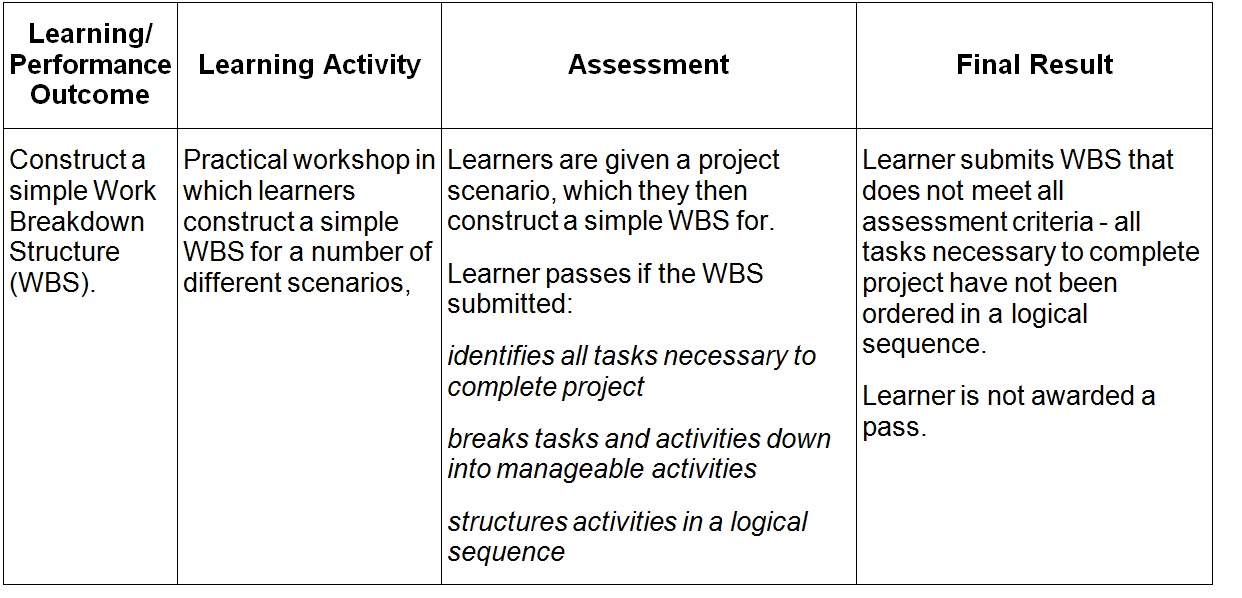As an early xmas present, James McLuckie of Eden Tree provides the community with a free constructive alignment resource.
One of the challenges of course or learning design is to put together activities or solutions that are fit for purpose for both the learning professional and the learner. Constructive alignment is a technique to ensure that learning/performance outcomes, learning methods, and assessment are all integrated and aligned with each other, resulting in a cohesive design that makes sense to learning professionals and learners alike.
Why ‘constructive alignment’?
A four-step process
- Define intended learning/performance outcomes. These should detail not just what needs to be understood or mastered, but to what level, so that learners are clear on what they need to achieve
- Select learning activities likely to lead to learning outcomes being achieved. These need to help learners turn declarative knowledge (reciting knowledge, either orally or in writing) into functioning knowledge (putting knowledge to work in the way it was intended). One way of helping learners see this distinction is to express learning/performance outcomes in explicit terms, e.g. demonstrate, perform, build etc.
- Assess learners against learning/performance outcomes. Because of the specific nature of the learning/performance outcomes, learning professionals should have a clear benchmark against which to assess the learner. Assessment methods and criteria should be clearly communicated to learners in advance of any assessment taking place
- Arrive at a final result. There should now be a clear process in place to arrive at an appropriate result for the learning, e.g. pass/fail, competent/not competent, A/B/C etc.
An example of constructive alignment in action is given below (for a project management course):

Constructive alignment template
- The first step is to detail the learning/performance outcomes of your course. Remember to make these specific and measurable, if possible. (You may consider using the S.M.A.R.T. methodology to construct these)
- Next consider appropriate learning activities that will facilitate the attainment of each particular outcome, and record these alongside it
- Finally, make a note of a suitable assessment method that enables the learner to demonstrate that they have achieved the learning outcome
The attached template has been designed to be completed on screen. If you are intending to print it off and complete it by hand you are advised to increase the size of the rows.
Source: Biggs, J. (1996). Enhancing Teaching Through Constructive Alignment. Higher Education, 32, 347 – 364.
If you have a free resource you would like to share with other TZ members, drop us a line: editor@trainingzone.co.uk
As an early xmas present, James McLuckie of Eden Tree provides the community with a free constructive alignment resource.
One of the challenges of course or learning design is to put together activities or solutions that are fit for purpose for both the learning professional and the learner. Constructive alignment is a technique to ensure that learning/performance outcomes, learning methods, and assessment are all integrated and aligned with each other, resulting in a cohesive design that makes sense to learning professionals and learners alike.
Why 'constructive alignment'?
This approach has two advantages. Firstly, considering all of these elements in tandem should ensure that there is a consistent clarity of thought and cohesiveness throughout the course.
Secondly, Biggs argues that learners and learning professionals often consider assessment in different ways. Learning professionals may see assessment as the end of a learning process, whereas many learners see it as the start – from the beginning, they focus on how they will be assessed and make their learning goal passing assignments, rather than concentrating on the subject matter itself. However, by aligning learning outcomes, learning methods and assessment, learners need to know the curriculum/course content in order to pass assignments.
A four-step process
- Define intended learning/performance outcomes. These should detail not just what needs to be understood or mastered, but to what level, so that learners are clear on what they need to achieve
- Select learning activities likely to lead to learning outcomes being achieved. These need to help learners turn declarative knowledge (reciting knowledge, either orally or in writing) into functioning knowledge (putting knowledge to work in the way it was intended). One way of helping learners see this distinction is to express learning/performance outcomes in explicit terms, e.g. demonstrate, perform, build etc.
- Assess learners against learning/performance outcomes. Because of the specific nature of the learning/performance outcomes, learning professionals should have a clear benchmark against which to assess the learner. Assessment methods and criteria should be clearly communicated to learners in advance of any assessment taking place
- Arrive at a final result. There should now be a clear process in place to arrive at an appropriate result for the learning, e.g. pass/fail, competent/not competent, A/B/C etc.
An example of constructive alignment in action is given below (for a project management course):

Constructive alignment template
- The first step is to detail the learning/performance outcomes of your course. Remember to make these specific and measurable, if possible. (You may consider using the S.M.A.R.T. methodology to construct these)
- Next consider appropriate learning activities that will facilitate the attainment of each particular outcome, and record these alongside it
- Finally, make a note of a suitable assessment method that enables the learner to demonstrate that they have achieved the learning outcome
The attached template has been designed to be completed on screen. If you are intending to print it off and complete it by hand you are advised to increase the size of the rows.
Source: Biggs, J. (1996). Enhancing Teaching Through Constructive Alignment. Higher Education, 32, 347 – 364.
If you have a free resource you would like to share with other TZ members, drop us a line: editor@trainingzone.co.uk




